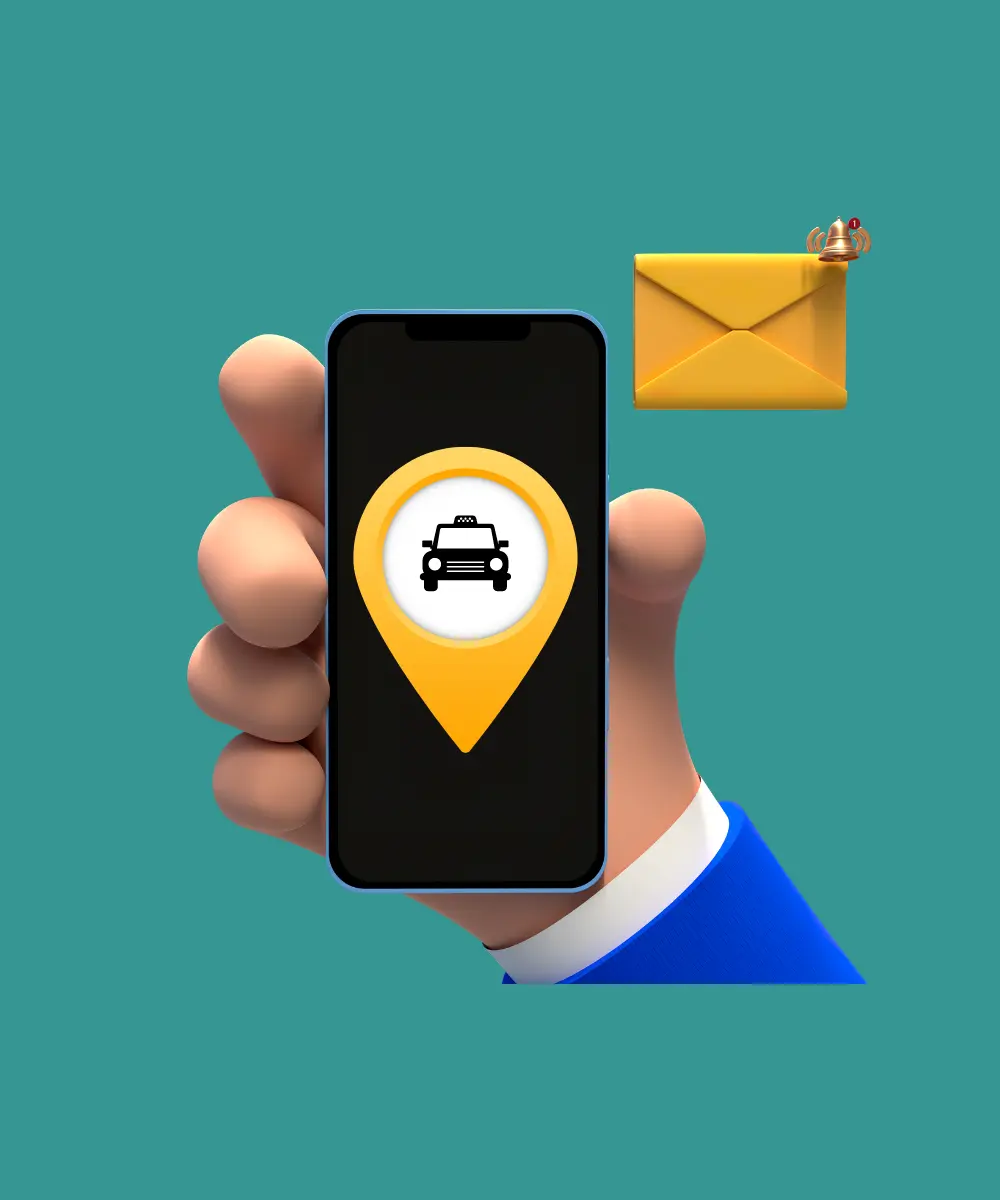Introduction
In today's urban world, taxi booking apps have reshaped how we think about transportation, making rides accessible with just a few taps on a smartphone. This revolution in mobility has opened up a lot of opportunities for businesses looking to enter or expand in this domain. With our extensive experience in developing high-performance taxi booking apps, What the Flutter stands at the forefront of this evolution, deeply understanding the trends and technical nuances that define success in this space.
Based on our expertise, this article is a short and detailed guide to making a taxi booking app. Whether you're starting fresh or aiming to enhance your existing app, our insights will guide you through the critical aspects of the development process, market trends and essential features. Let's dive into the world of taxi booking app development together, unlocking the potential for innovation and growth in the dynamic digital marketplace of 2024.
Taxi Booking App Landscape Overview
As we move into 2024, several key trends are shaping the future of taxi booking app development, understanding of which is crucial for businesses.
- Emphasis on sustainable and eco-friendly rides: The push for sustainability is leading to an uptick in eco-friendly rides, with electric and hybrid vehicles becoming staples in taxi fleets. Apps that support the booking of green vehicles are gaining popularity, emphasizing environmental responsibility.
- Integration of AI and ML: Artificial intelligence and machine learning are transforming taxi booking apps, enhancing personalized service and operational efficiency through predictive analytics, AI chatbots, and real-time route optimization.
- Enhanced security features: As digital transactions increase, advanced security measures like biometric authentication, end-to-end encryption, and secure payment gateways are becoming essential, building trust and retaining customers.
- Blockchain for transparency and efficiency: Blockchain technology promises to bring transparency and efficiency, offering secure transactions and the potential for decentralized services, thereby enhancing reliability and reducing costs.
- Rise of ride-sharing and pooling options: Ride-sharing and pooling are emerging as economical and eco-friendly transport options, appealing to cost-conscious and environmentally aware users by offering affordable rides and reducing traffic congestion.
- User experience personalization: Personalizing user experiences with features like preferred driver selection and customizable options is key to enhancing satisfaction and fostering loyalty among users.
- Integration of multiple payment systems: The diversification of payment methods, including e-wallets, bank transfers, and cryptocurrencies, supported by blockchain technology, is setting new standards in convenience and security.
- Government regulations and partnerships: The evolving regulatory landscape and partnerships with governments aim to improve urban mobility, promote eco-friendly vehicles, and ensure safety and fairness, leading apps to adapt with compliant features.
- Expansion of services: Beyond simple taxi booking, apps are expanding their range of services to include food delivery, parcel delivery, and even financial services. This diversification not only opens new revenue streams but also increases user engagement by turning the app into a one-stop solution for multiple needs.
These trends show that being innovative, focusing on the user, and being eco-friendly are key in the taxi app market. Developers and businesses that keep up with these trends and keep improving their apps will succeed in the changing digital world.
Types of Taxi Booking Apps
Taxi booking apps are diverse, catering to different market needs and user preferences. These apps can be classified into three main types: aggregator apps, branded taxi apps, and ride-sharing apps.
Aggregator apps
Aggregator apps serve as a platform connecting passengers with various taxi services and independent drivers. These apps don't own any vehicles but partner with existing service providers to offer users a wide range of options. They are known for their extensive network, flexibility, and competitive pricing.
- Example: Uber
Uber is perhaps the most recognized name in this category, operating in numerous countries around the world. It aggregates services from local drivers and offers multiple ride options, from affordable economy cars to premium vehicles, catering to a broad user base. - Example: Lyft
Lyft, another prominent player, operates similarly to Uber but places a stronger emphasis on community and driver-passenger connection. It's widely used in the United States and is known for its friendly, inclusive culture.

Branded taxi apps
Branded taxi apps are developed by existing taxi companies wishing to digitalize their services. These apps allow users to book rides directly with specific companies, offering a more personalized experience. They often include loyalty programs, ensuring that customers remain engaged and prefer their services over competitors.
- Example: Yellow Cab
Yellow Cab, a traditional taxi service, has developed its own app to modernize its offerings. Through the app, customers can book rides, track their taxi in real-time, and make cashless payments, providing a seamless transition from traditional to digital taxi services. - Example: Gett
Gett is another example, originally started as a branded app for black cabs and premium taxis. It has expanded its service to include corporate transportation solutions, emphasizing reliability and quality of service for business users.
Ride-sharing apps
Ride-sharing apps focus on connecting passengers traveling in the same direction, allowing them to share rides and costs. These apps are eco-friendly and budget-friendly, appealing to a demographic that values sustainability and social interaction.
- Example: BlaBlaCar
BlaBlaCar is a long-distance ride-sharing service connecting drivers with empty seats to passengers looking for a ride. It's a popular choice for inter-city travel in Europe, allowing users to save money while reducing their carbon footprint. - Example: Carpool by Waze
Carpool by Waze, developed by the well-known navigation service Waze, connects commuters traveling to similar destinations. It encourages carpooling to reduce traffic congestion and pollution, offering a convenient solution for daily commutes.
Each of these types of taxi booking apps addresses different aspects of consumer needs and market demands. Understanding these distinctions is crucial for businesses aiming to enter the taxi booking app market, as it helps in identifying the target audience and shaping the app's features and services accordingly.
Key Features to Add in Taxi Booking App
To create a robust and user-friendly taxi booking app, it's essential to focus on features tailored to the needs of three main stakeholders: passengers (users), drivers, and administrators. Each group requires specific functionalities to ensure a seamless, efficient, and enjoyable experience. Below, we break down the must-have features for each category.
Must-have features for users
- Easy registration and profile management: Allow users to sign up quickly using their email, mobile number, or social media accounts, and manage their profiles, including preferred payment options and ride history.
- Intuitive booking interface: Users should be able to book a ride with just a few taps, specifying pickup and drop-off locations, selecting vehicle types, and viewing fare estimates.
- Real-time tracking: After booking, users must be able to track their driver's location in real-time, ensuring transparency and safety.
- Flexible payment options: Incorporate multiple payment methods, including credit/debit cards, e-wallets, and cash, catering to user preferences for convenience.
- Rating and feedback system: Implement a system for users to rate their ride experience and provide feedback about the driver, which helps maintain service quality.
Must-have features for drivers
- Driver registration and verification: A secure process for drivers to register, submit necessary documents, and undergo a verification process to ensure safety and reliability.
- Trip alerts: Drivers should receive notifications of new booking requests, allowing them to accept or decline based on availability and convenience.
- Navigation and route optimization: Integrated GPS and route optimization features help drivers find the best routes, reducing travel time and improving efficiency.
- Earnings tracker: A feature for drivers to track their earnings, view trip histories, and manage payouts, which aids in financial planning and motivation.
- Driver support and feedback: Access to support in case of issues and the ability to receive feedback from passengers to improve their service.
Must-have features for admin panel
- Dashboard: A comprehensive dashboard providing an overview of app activity, including active rides, number of drivers and users, earnings, and more.
- Driver and user management: Tools for managing driver and user accounts, including verification, approval, and the ability to deactivate users or drivers as necessary.
- Fare management: The ability to set and adjust fare rates based on vehicle type, demand, and other factors, ensuring competitiveness and profitability.
- Analytics and reporting: Access to detailed analytics and reports on app usage, revenue, user demographics, and driver performance to inform decision-making.
- Customer support module: A system to manage customer queries and complaints, ensuring users and drivers receive timely assistance and resolutions.
Focusing on these tailored features for users, drivers, and the admin panel will ensure that your taxi booking app caters effectively to the needs of all stakeholders, setting the foundation for a successful and scalable platform.
How To Create a Taxi Booking App in 5 Steps?
Creating a taxi booking app that resonates with users and stands the test of time requires a strategic approach. Here's a streamlined, five-step process for developing a taxi booking app.
1. Market analysis and conceptualization
- Understanding user needs and market gaps: Begin with in-depth market research to understand the needs of your target audience and identify gaps in the existing market. This involves analyzing competitor offerings, user reviews, and current market trends. Utilize surveys, focus groups, and competitor analysis tools to gather insights.
- Defining the unique value proposition (UVP): Based on your research, articulate a clear UVP that addresses unmet needs or offers a significantly better solution than what's currently available. This could range from offering the lowest price points to providing luxury services or focusing on niche markets like environmentally friendly rides.
2. Design and UX

- Crafting a user-centric design: Design is not just about aesthetics; it's about creating an intuitive user experience. Focus on simplifying the journey from opening the app to booking a ride. This includes creating a logical flow, minimizing the number of taps required to book a ride, and ensuring the app is accessible to users with disabilities.
- Interactive prototyping: Develop prototypes that simulate the real app experience. Tools like Figma or Adobe XD can help create interactive prototypes that are invaluable for user testing. Gather feedback from potential users and iterate on the design before moving into development.
3. Development and quality assurance
- Choosing the right technology stack: Select a technology stack that ensures scalability, security, and cross-platform compatibility. For instance, using Flutter can allow for efficient cross-platform development, while Node.js can serve as a powerful backend solution.
- Agile development process: Adopt an agile development methodology, dividing the project into sprints that focus on delivering specific features. This approach promotes flexibility, faster time to market, and continuous improvement based on feedback.
- Testing: Conduct extensive testing, including unit tests, integration tests, and user acceptance tests (UAT), to ensure the app is reliable, secure, and user-friendly. Pay special attention to testing the app under various network conditions and on multiple device types.
4. Launch strategy and user acquisition

- App store optimization (ASO): Before launch, optimize your app’s listing on app stores with compelling descriptions, keywords, and visuals. ASO is crucial for improving visibility and attracting organic users.
- Marketing and promotion: Develop a comprehensive marketing strategy that includes social media marketing, influencer partnerships, and targeted ads. Consider launching a referral program to encourage existing users to invite their friends.
- Gathering initial user feedback: After launch, closely monitor user feedback and app performance metrics. This initial feedback is invaluable for identifying any issues and understanding user needs better.
5. Iteration, feedback, and scaling
- Continuous improvement: Use user feedback and performance data to continuously improve the app. Prioritize updates based on user demand and the strategic importance of features.
- Scaling the app: As your user base grows, you'll need to scale your app's infrastructure to maintain performance. This could involve optimizing your database, expanding your server capacity, or implementing more efficient code.
- Expanding to new markets: Consider geographical expansion or adding new services to your app as it grows. Each new market or service will require its own set of research and customization to meet local needs and preferences.

By following these five steps and focusing on continuous improvement and user feedback, you can build a taxi booking app that not only meets the current demands of the market but is also poised for future growth and success.
How Much Does It Cost to Create Taxi Booking App?

The cost of creating a taxi booking app varies significantly based on the complexity of the app, the chosen technology stack, and the geographic location of the development team. Typically, taxi booking apps can be categorized into three sizes: small, mid-level, and large. Here's a view of the cost implications for each size, considering budget, timeline, and general features.
Small taxi booking app
Budget: The development cost for a small taxi booking app ranges from $10,000 to $20,000. This variation depends largely on whether the app is developed in a high-cost region like North America or a lower-cost region such as Europe.
Timeline: A small app can take anywhere from 2 to 4 months to develop, given a straightforward set of features and a single platform focus (iOS or Android).
General features:
- User registration and profile management
- Basic ride booking and cancellation
- GPS tracking of the ride
- Payment gateway integration
- Driver and vehicle details
- Rating and reviews
This version is typically targeted at startups or businesses looking to test the market with a minimal viable product (MVP).
Mid-level taxi booking app
Budget: Developing a mid-level app can cost between $20,000 and $50,000. This price range accommodates more sophisticated features and possibly development for both iOS and Android platforms using a cross-platform framework.
Timeline: The development timeline for a mid-level app can range from 4 to 7 months. This extended timeline allows for the incorporation of more complex features and the development of a more refined user interface and experience.
General features: Includes all features of the basic app, plus:
- Advanced booking options (e.g., scheduling a ride for a later time)
- In-app messaging between drivers and passengers
- Fare estimates and dynamic pricing
- Enhanced payment options (e.g., wallet system)
- Loyalty programs or promotions
- Accessibility features for disabled users
This version is suitable for businesses ready to make a more significant investment to offer a competitive product in the market.
Large taxi booking app
Budget: The development cost for a large taxi booking app can vary from $50,000, potentially reaching up to $200,000 or more. This budget covers comprehensive features, high-end customizations, and scalability options.
Timeline: Such an app could take over 7-12 months to develop, considering the complexity, testing, and deployment phases involved.
General features:
Includes all features of the mid-level app, plus:
- AI-driven analytics for route optimization and demand forecasting
- Blockchain technology for secure transactions
- Real-time alerts and notifications
- Multi-language support
- Integration with third-party services (e.g., music streaming, in-app chat)
- Advanced safety features (e.g., SOS button, ride sharing with family)
A large app is aimed at established businesses or corporations looking to dominate the market with a comprehensive set of features that enhance user experience, operational efficiency, and safety.
The cost to create a taxi booking app is influenced by the app's complexity, the geographic location of the development team, and the chosen technology stack. Each step up in complexity not only increases development cost and time but also enhances the app's ability to meet diverse user needs and stand out in a competitive landscape.
Conclusion
Developing a taxi booking app is a real challenge that blends technology, market insight, and user experience into a service that can transform urban mobility. The domain is rapidly expanding, promising significant returns for those willing to invest in this transformative sector.
What the Flutter brings experience to the table, with a proven track record in the European market through the successful development of three distinct taxi booking applications. This experience deepened our understanding of what it takes to succeed in the competitive app marketplace. Reach out to us to start your journey today. Whether your aim is to test the waters with an MVP or to dominate the market with a feature-rich application, we are equipped with the knowledge, skills, and technology to bring your vision to life.











